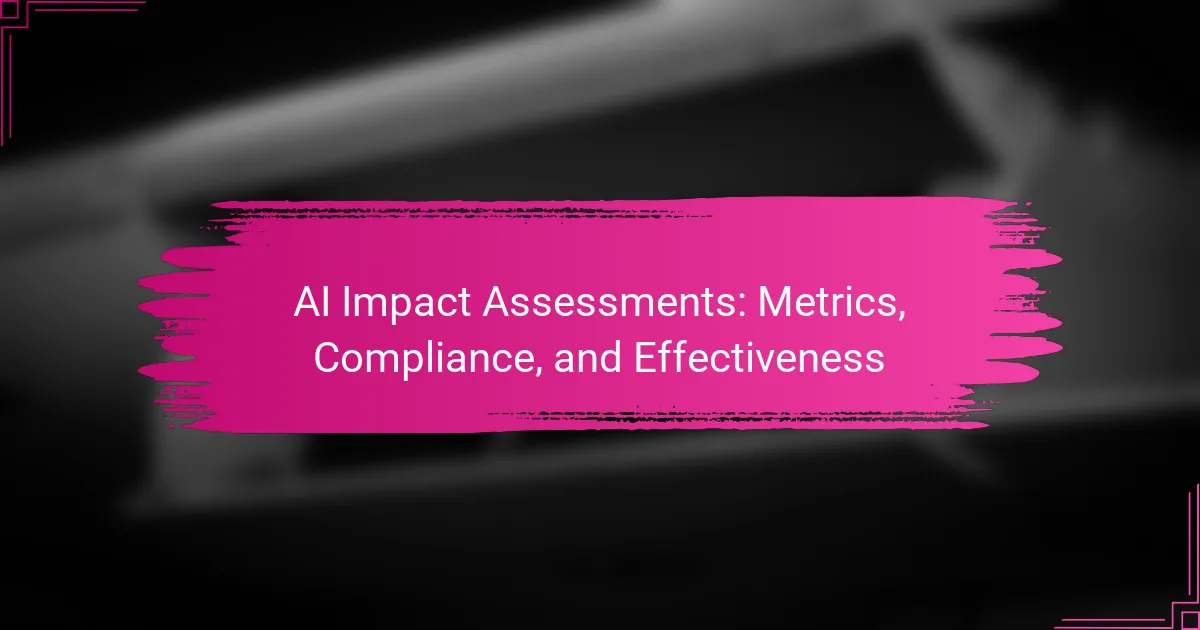AI impact assessments are crucial for evaluating the effectiveness and compliance of artificial intelligence systems, focusing on key metrics such as accuracy, bias, and transparency. By adhering to relevant regulations and ethical guidelines, organizations can systematically assess the potential risks and benefits of AI technologies. Engaging stakeholders and employing best practices ensures that these assessments are thorough and contribute to responsible AI deployment.
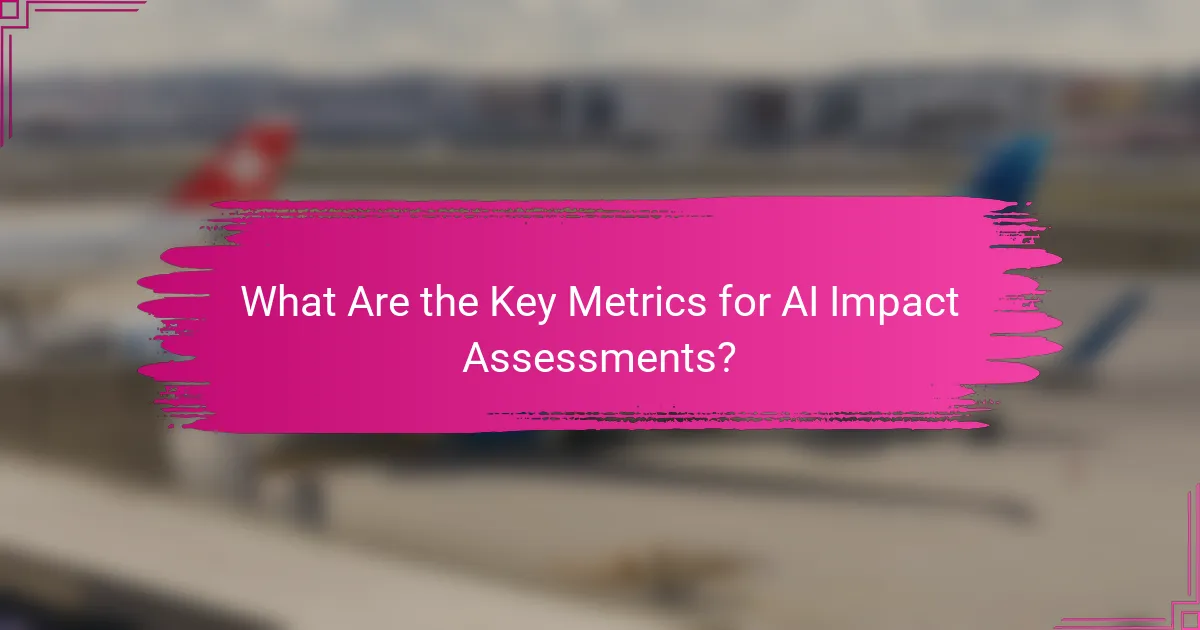
You can learn more in our homepage.
What Are the Key Metrics for AI Impact Assessments?
Key metrics for AI impact assessments include accuracy, bias, transparency, performance, and stakeholder satisfaction. These metrics help evaluate the effectiveness and compliance of AI systems in various applications, ensuring they meet ethical and operational standards.
Accuracy and Precision
Accuracy refers to how closely the AI’s outputs align with the true values or expected results. Precision measures the consistency of these outputs across multiple trials. For instance, in a medical diagnosis AI, high accuracy means correctly identifying diseases, while high precision indicates consistent results across different patient data.
To assess accuracy and precision, consider using confusion matrices and performance metrics like F1 scores. Aim for accuracy rates above 80% for critical applications, but be aware that context matters; some fields may require even higher thresholds.
Bias and Fairness
Bias in AI systems can lead to unfair treatment of certain groups, impacting decisions in hiring, lending, and law enforcement. Fairness metrics help identify and mitigate these biases, ensuring equitable outcomes across diverse populations.
Common approaches to evaluate bias include demographic parity and equal opportunity metrics. Regular audits and diverse training datasets can help reduce bias, aiming for systems that treat all users fairly regardless of their background.
Transparency and Explainability
Transparency involves making AI processes understandable to users, while explainability refers to the ability to clarify how decisions are made. These aspects are crucial for building trust and ensuring accountability in AI applications.
Implementing explainable AI techniques, such as LIME or SHAP, can help stakeholders grasp the reasoning behind AI outputs. Strive for systems where users can easily access explanations for decisions, particularly in regulated industries like finance and healthcare.
Performance and Efficiency
Performance metrics evaluate how well an AI system operates under various conditions, while efficiency measures resource usage, such as processing time and energy consumption. High-performance AI should deliver results quickly without excessive resource expenditure.
Consider benchmarks like response times in milliseconds for real-time applications. Aim for systems that balance performance with efficiency, ensuring they can scale without significant increases in operational costs.
Stakeholder Satisfaction
Stakeholder satisfaction gauges how well the AI system meets the needs and expectations of its users. This metric is vital for adoption and long-term success, as dissatisfied users may reject or underutilize the technology.
Conduct regular surveys and feedback sessions to assess user satisfaction. Focus on usability, effectiveness, and support, aiming for high satisfaction scores to foster acceptance and integration of AI solutions in various sectors.
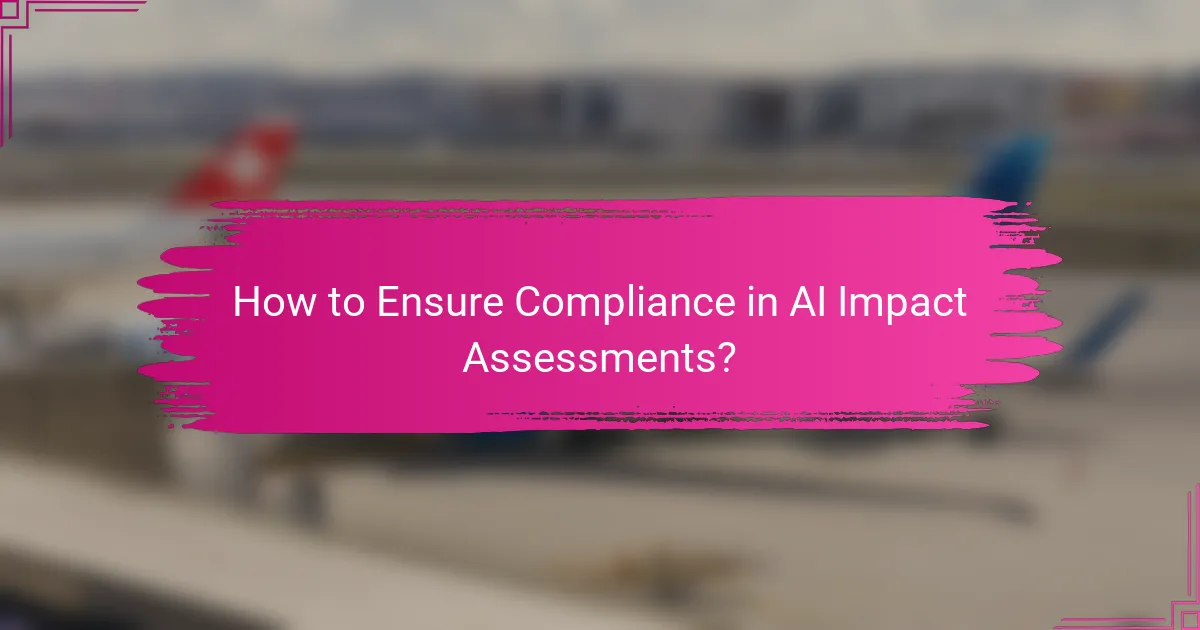
How to Ensure Compliance in AI Impact Assessments?
Ensuring compliance in AI impact assessments involves adhering to relevant regulations, standards, and ethical guidelines. Organizations must implement structured processes to evaluate the potential effects of AI systems on individuals and society.
You can explore various resources in AI impact assessment tools.
Regulatory Frameworks
Regulatory frameworks provide the legal basis for conducting AI impact assessments. In many regions, such as the European Union, regulations like the General Data Protection Regulation (GDPR) outline specific requirements for transparency and accountability in AI systems.
Organizations should familiarize themselves with local laws and international standards that govern AI use. This includes understanding the implications of non-compliance, which can lead to significant fines and reputational damage.
Data Protection Standards
Data protection standards are crucial for ensuring that AI systems handle personal data responsibly. Compliance with standards such as GDPR or the California Consumer Privacy Act (CCPA) requires organizations to implement measures for data minimization, user consent, and data security.
Regular audits and assessments can help identify potential vulnerabilities in data handling practices. Organizations should also establish clear protocols for data access and sharing to mitigate risks associated with data breaches.
Ethical Guidelines
Ethical guidelines are essential for promoting fairness and accountability in AI systems. Organizations should adopt frameworks that prioritize human rights, such as the OECD Principles on Artificial Intelligence, which emphasize transparency, inclusivity, and accountability.
Implementing ethical guidelines involves training teams on responsible AI practices and conducting regular reviews of AI systems to ensure they align with ethical standards. Engaging stakeholders in discussions about ethical implications can also enhance trust and acceptance.
Industry Best Practices
Adopting industry best practices can significantly enhance compliance in AI impact assessments. This includes establishing a multidisciplinary team to oversee assessments, utilizing standardized assessment tools, and maintaining thorough documentation of processes and findings.
Organizations should also stay updated on emerging trends and technologies that could affect compliance. Networking with industry peers and participating in forums can provide valuable insights and foster collaborative approaches to compliance challenges.

What Are the Best Practices for Effective AI Impact Assessments?
Effective AI impact assessments focus on identifying potential risks and benefits associated with AI systems. Best practices include engaging stakeholders, employing iterative assessment processes, utilizing standardized tools, and ensuring regular reporting and review.
Stakeholder Engagement
Engaging stakeholders is crucial for understanding diverse perspectives and potential impacts of AI systems. This involves identifying relevant parties, such as users, affected communities, and regulatory bodies, and actively involving them in the assessment process.
To facilitate effective engagement, consider organizing workshops or surveys to gather input and feedback. This collaborative approach helps in identifying concerns early and fosters transparency, which can enhance trust in AI implementations.
Iterative Assessment Processes
Iterative assessment processes allow for continuous evaluation and refinement of AI systems throughout their lifecycle. This means regularly revisiting impact assessments as new data and insights emerge, rather than treating them as a one-time task.
Establish checkpoints at various stages of development to assess compliance with ethical standards and regulatory requirements. This proactive approach can help mitigate risks before they escalate, ensuring that the AI system remains aligned with its intended purpose.
Use of Standardized Tools
Utilizing standardized tools for AI impact assessments can streamline the evaluation process and ensure consistency. These tools often include frameworks and checklists that help assess various dimensions of AI systems, such as fairness, accountability, and transparency.
Examples of standardized tools include the AI Ethics Framework and the Algorithmic Impact Assessment Toolkit. Implementing these resources can facilitate a more structured approach, making it easier to compare assessments across different projects.
Regular Reporting and Review
Regular reporting and review of AI impact assessments are essential for maintaining accountability and transparency. Establish a schedule for reporting findings to stakeholders and regulatory bodies, ensuring that updates are timely and informative.
Consider creating a dashboard or summary report that highlights key metrics and findings, making it easier for stakeholders to understand the impact of AI systems. This practice not only fosters trust but also encourages ongoing dialogue about potential improvements and necessary adjustments.
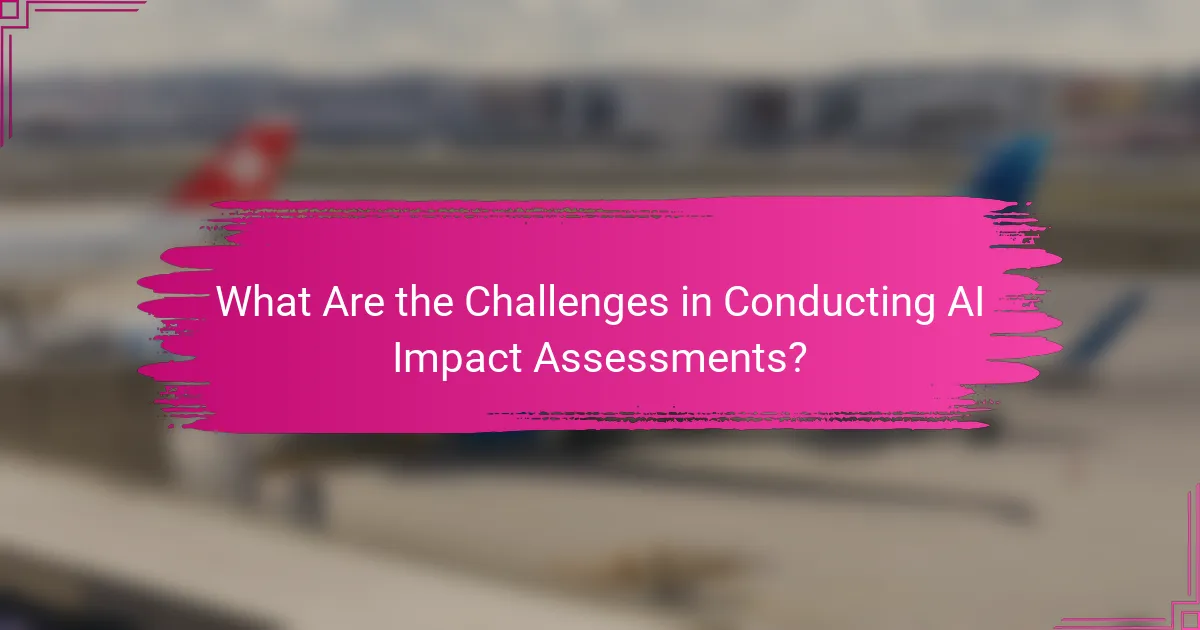
What Are the Challenges in Conducting AI Impact Assessments?
Conducting AI impact assessments presents several challenges that can hinder their effectiveness. Key issues include data quality, resource limitations, the inherent complexity of AI systems, and resistance to change within organizations.
Data Quality Issues
Data quality is critical for accurate AI impact assessments. Poor quality data can lead to misleading results, making it essential to ensure that the data used is accurate, complete, and representative of the target population.
Common data quality issues include missing values, biased samples, and outdated information. Organizations should implement robust data validation processes and continuously monitor data sources to maintain high standards.
Resource Limitations
Many organizations face resource limitations when conducting AI impact assessments, including budget constraints and a lack of skilled personnel. These limitations can restrict the depth and breadth of the assessment process.
To mitigate these challenges, organizations can prioritize assessments based on potential impact, seek external expertise, or leverage automated tools that can streamline data collection and analysis.
Complexity of AI Systems
The complexity of AI systems poses a significant challenge for impact assessments. Understanding the intricacies of algorithms, data flows, and decision-making processes is crucial for evaluating their effects accurately.
Organizations should adopt a systematic approach to decompose AI systems into manageable components. This can involve mapping out workflows and identifying key performance indicators to facilitate a clearer assessment of impacts.
Resistance to Change
Resistance to change can impede the implementation of AI impact assessments. Stakeholders may be hesitant to adopt new processes or alter existing workflows, fearing disruptions or additional workload.
To overcome resistance, organizations should communicate the benefits of AI impact assessments clearly and involve stakeholders in the assessment process. Providing training and resources can also help ease transitions and foster a culture of continuous improvement.
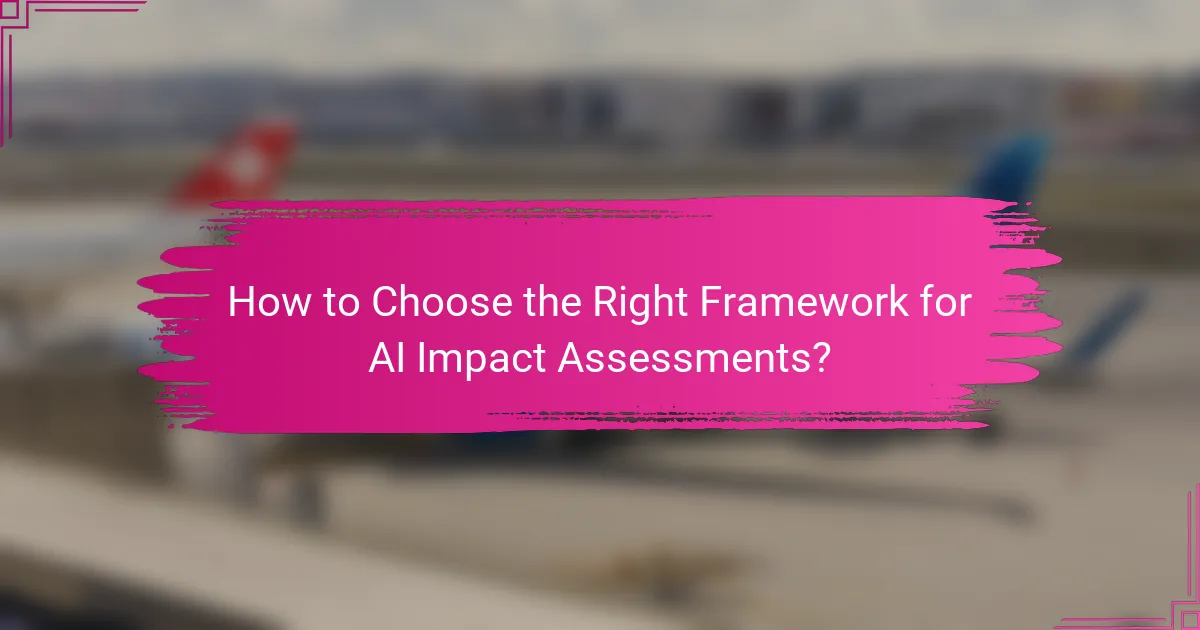
How to Choose the Right Framework for AI Impact Assessments?
Selecting the appropriate framework for AI impact assessments involves evaluating various methodologies based on their effectiveness, compliance with regulations, and alignment with your organization’s goals. Key considerations include the framework’s adaptability to your specific AI applications and its ability to measure relevant metrics effectively.
Framework Comparison
For instance, the EU’s framework may be more suitable for organizations operating within Europe due to its stringent regulations, while the IEEE standards might appeal to companies prioritizing ethical AI development globally. A simple comparison table can help visualize these differences:
| Framework | Focus Area | Best For |
|---|---|---|
| EU AI Act | Regulatory Compliance | Organizations in Europe |
| IEEE Standards | Ethical Considerations | Global Developers |
Alignment with Organizational Goals
Choosing a framework that aligns with your organizational goals is crucial for effective AI impact assessments. Start by identifying your primary objectives, such as improving customer trust, ensuring compliance, or enhancing operational efficiency. This clarity will guide you in selecting a framework that supports these aims.
For example, if your goal is to foster transparency in AI usage, a framework that emphasizes explainability and user engagement will be essential. Regularly review and adjust your chosen framework to ensure it continues to meet your evolving organizational needs and complies with any new regulations that may arise.
